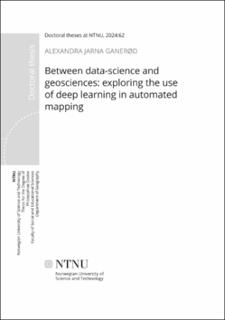| dc.contributor.advisor | Rød, Jan Ketil | |
| dc.contributor.advisor | Calovi, Martina | |
| dc.contributor.advisor | Fredin, Hans Ola | |
| dc.contributor.author | Ganerød, Alexandra Jarna | |
| dc.date.accessioned | 2024-04-10T12:09:31Z | |
| dc.date.available | 2024-04-10T12:09:31Z | |
| dc.date.issued | 2024 | |
| dc.identifier.isbn | 978-82-326-7723-8 | |
| dc.identifier.issn | 2703-8084 | |
| dc.identifier.uri | https://hdl.handle.net/11250/3125815 | |
| dc.description.abstract | Artificial intelligence (AI) is one of the fastest-growing disciplines in information technology and has been successfully applied in many different fields. Currently, the technology is available for everyone but remains challenging due to its complexity. This Ph.D. research takes up the challenge and aims to bridge the disciplinary gap between data science and geoscience. In geoscience, traditional mapping relies heavily on manual labour, data analysis, and expert knowledge and thus could be done more efficiently using AI technology. This PhD demonstrates how non-experts can harness and integrate deep learning for mapping purposes based on the use of freely available data (e.g., terrain derivates and satellite imagery, Landsat 8, Sentinel-1, and Sentinel-2) to simplify daily tasks and to improve future work processes. Deep learning is the subset of machine learning methods based on artificial neural networks.
This article-based thesis consists of six independents. However, they are interrelated research articles that use deep learning applications for semi-automatic geospatial classification. It identifies critical geoscientific features such as outcrops, wetlands, landslides, and ravines. Deep learning proved to support and improve hazard assessment and support new mapping strategies with the use of available technology. The research highlights the importance of interdisciplinary collaboration between data scientists and geoscientists to drive innovation and maximize the potential of deep learning. Bridging the gap between expert data science knowledge and geoscience expertise, this research makes significant contributions to a more sustainable future for expert-based decisions.
Moreover, this study evolved over the last four years and identified the approach of combining predictions of multiple models as a promising approach (ensemble models).
In conclusion, the main contribution of the study shows practical implications for the geoscience community, as well as for the society at large. The application of automated mapping can lead to a better understanding of geospatial processes over larger areas and their impact on the environment. | en_US |
| dc.language.iso | eng | en_US |
| dc.publisher | NTNU | en_US |
| dc.relation.ispartofseries | Doctoral theses at NTNU;2024:62 | |
| dc.relation.haspart | Paper 1: Jarna, Alexandra; Bakkestuen, Vegar; Calovi, Martina; Fredin, Ola; Rød, Jan Ketil. Where are the outcrops? Automatic delineation of bedrock from sediments using Deep-Learning techniques. Applied Computing and Geosciences 2023 ;Volum 18. https://doi.org/10.1016/j.acags.2023.100119 This is an open access article under the CC BY license (http://creativecommons.org/licenses/by/4.0/). | en_US |
| dc.relation.haspart | Paper 2: Bakkestuen, Vegar; Venter, Zander; Ganerød, Alexandra Jarna; Framstad, Erik. Delineation of Wetland Areas in South Norway from Sentinel-2 Imagery and LiDAR Using TensorFlow, U-Net, and Google Earth Engine. Remote Sensing 2023 ;Volum 15.(5) https://doi.org/10.3390/rs15051203 This article is an open access article distributed under the terms and conditions of the Creative Commons Attribution (CC BY) license (https://creativecommons.org/licenses/by/4.0/). | en_US |
| dc.relation.haspart | Paper 3: Jarna, Alexandra; Lindsay, Erin Rose Pilaar; Fredin, Ola; Myrvoll, Tor Andre; Nordal, Steinar; Rød, Jan Ketil. Globally vs. Locally Trained Machine Learning Models for Landslide Detection: A Case Study of a Glacial Landscape. Remote Sensing 2023 ;Volum 15.(4) https://doi.org/10.3390/rs15040895 This article is an open access article distributed under the terms and conditions of the Creative Commons Attribution (CC BY) license (https://creativecommons.org/licenses/by/4.0/). | en_US |
| dc.relation.haspart | Paper 4:
Lindsay, E.; Jarna Ganerød, A.; Devoli, G.; Reiche, J.; Nordal, S.; Frauenfelder, R.; Tokle, L.
Understanding Landslide Expression in SAR Backscatter Data: A Global Study - Preprints 2023, 2023020390. https://doi.org/10.20944/preprints202302.0390.v1 | en_US |
| dc.relation.haspart | Paper 5:
Alexandra Jarna Ganerød, Gabriele Franch, Erin Lindsay, Martina Calovi.
Automating global landslide detection with heterogeneous ensemble deep. arXiv
https://doi.org/10.48550/arXiv.2310.05959 | en_US |
| dc.relation.haspart | Paper 6: Alexandra Jarna Ganerød, Mikis van Boeckel, Inger-Lise Solberg. Where are the ravines? A Case Study of Gully Landscapes in Norway Using Deep Learning. Authorea. August 25, 2023. DOI: 10.22541/au.169230564.41279479/v2 | en_US |
| dc.title | Between data-science and geosciences: exploring the use of deep learning in automated mapping | en_US |
| dc.type | Doctoral thesis | en_US |
| dc.subject.nsi | VDP::Social science: 200 | en_US |
